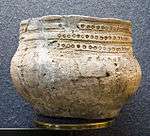Catacomb culture

| Bronze Age |
|---|
| ↑ Chalcolithic |
|
Near East (c. 3300–1200 BC) South Asia (c. 3000– 1200 BC) Europe (c. 3200–600 BC)
China (c. 2000–700 BC) |
| ↓Iron Age |
| Part of a series on |
| Indo-European topics |
|---|
|
|
Origins |
|
Archaeology Pontic Steppe East-Asia Eastern Europe Northern Europe Pontic Steppe Northern/Eastern Steppe Europe South-Asia Steppe Europe Caucasus India |
|
Peoples and societies Indo-Aryans Iranians Europe East-Asia Europe Indo-Aryan Iranian |
|
Religion and mythology
Indian Iranian Other Europe |
The Catacomb culture (ca. 2800–2200 BC) is a group of related cultures in the early Bronze Age occupying essentially what is present-day eastern Ukraine and southern Russia.
The culture was the first to introduce corded pottery decorations into the steppes and shows a profuse use of the polished battle axe, providing a link to the West. Parallels with the Afanasevo culture, including provoked cranial deformations, provide a link to the East. It was preceded by the Yamna culture. The Catacomb culture in the Pontic steppe was succeeded by the Srubna culture from ca. the 17th century BC.
Economy and burial rites
The name Catacomb culture comes from its burial practices. These are similar to those of the Yamna culture, but with a hollowed-out space off the main shaft, creating the "catacomb". Animal remains were incorporated into a small minority of graves.
In certain graves there was the distinctive practice of what amounts to modelling a clay mask over the deceased's face, creating an obvious if not necessarily correct association to the famous gold funeral mask of Agamemnon (see also Tashtyk culture).
The economy was essentially stock-breeding, although traces of grain have been found. There seem to have been skilled specialists, particularly metal-workers.
Origin and demise
The origin of the Catacomb culture is disputed. Jan Lichardus[1] enumerates three possibilities: a local development departing from the previous Yamna Culture only, a migration from Central Europe, or an oriental origin. The culture is first to introduce corded pottery decorations into the steppes and shows a profuse use of the polished battle axe, providing a link to the West. Parallels with the Afanasevo culture, including provoked cranial deformations, provide a link to the East.
Excavations in 2012 of 26 mounds near Storozhove village in Chutove Region of Poltava Oblast revealed 3 layers of Catacomb culture archaeology. The earliest were the burials of the 'Donetsk' phase of Catacomb culture (also known as Dnieper–Donets culture); the dates were 3050—2190 cal BC. Then came the burials of 'Inhul' phase (named after Inhul river). Later material belonged to Berezhnivsko-Maivska type of Srubna culture (Timber-grave) (1880—1530 cal BC).[2]
The Catacomb culture was replaced by the Srubna culture from ca. the 17th century.
Language
The language of the Catacomb culture must naturally remain unknown. Within the context of the Kurgan hypothesis expounded by Marija Gimbutas, an Indo-European component is speculated about, particularly in the later stages. Placing the ancestors of the Greek, Albanian and Armenian (perhaps Paleo-Balkan) dialects here is tempting, as it would neatly explain certain shared features.
More recently, the Ukrainian archaeologist V. Kulbaka has argued that the Late Yamna cultures of ca. 3200–2800 BC, esp. the Budzhak, Starosilsk, and Novotitarovka groups, might represent the Balkan-Indo-European-"Aryan"(=Indo-Iranian) ancestors, and the Catacomb culture (to ca. 2500 BC) that of the then still unified Indo-Iranians. However, according to recent glottochronological computations, these splits occurred much earlier.
Grigoryev's (1998) version of the Armenian hypothesis connects Catacomb culture with Indo-Aryans, because catacomb burial ritual had roots in South-Western Turkmenistan from the early 4th millennium (Parkhai cemetery). The same opinion is supported by Leo Klejn in his various publications.
Artifacts
| Catacomb objects from the Hermitage Museum collections | ||||||||
|---|---|---|---|---|---|---|---|---|
|
See also
- Shaft grave
-
 Media related to Catacomb culture at Wikimedia Commons
Media related to Catacomb culture at Wikimedia Commons
Footnotes
- ↑ Jan Lichardus — La protohistoire de l'Europe, 1987, Book 1 Chapter III:III.1.A
- ↑ O.V. Kovalenko, D.P. Kushtan, R.S. Luhovyi, STRATIFIED BRONZE AGE BARROWS OF STOROZHOVE CEMETERY Археологія, 2012, № 3 (in Ukrainian)
References
- Grigoryev, S.A. (1998), "The Sintashta Culture and Some Questions of Indo-European Origins" (PDF), Proceedings of the Chelyabinsk Scientific Center (published October–December 1998) (2), pp. 82 ff..
- V. Kulbaka, "Indo-European populations of Ukraine in the paleometallic period", Mariupol 2000. ISBN 966-7329-30-5
- Mallory, J. P. (1997), "Catacomb Culture", Encyclopedia of Indo-European Culture, Fitzroy Dearborn.



